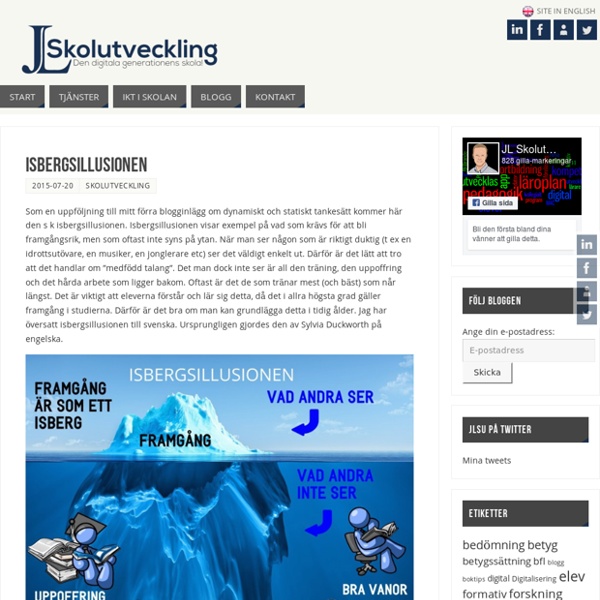



http://www.jlsu.se/isbergsillusionen/
Related: Growth Mindset • SkolutvecklingBecoming a growth mindset school The idea of becoming a growth mindset school has been over a year in the making. Our Headteacher bought each member of SLT a copy of Mindset for Christmas, and it was the main agenda item at our annual senior team conference. Today I launched the idea of becoming a growth mindset school to all staff at our INSET day. This is the basis of the presentation I did. Our INSET session was for all staff – teaching, support, administrative, catering, site, network, technicians – everyone!
35 More Ways to Use Google Classroom Back when I had only had a list of 35 ways to use Google Classroom I submitted a poster session proposal to ISTE. Since then the list has grown and you can now purchase “50 Things You Can Do With Google Classroom” on Amazon. For my poster session I have come up with an additional 35 ways you can use Google Classroom. 6 ways to teach growth mindset from day one of school Imagine if your new class this fall was full of students who would: Be willing to try new thingsStick with hard tasks and not give upPush themselves to do their best work, not just what’s “good enough”Believe in themselves and their own ability to learn Here’s the great news–these are traits that we can help develop in our students by teaching them about how their brains work. Many students enter our classrooms believing they’re either smart or not smart, good at reading or math, or not good in those areas. This belief that our basic qualities like intelligence and talents can’t be changed is called a fixed mindset.
Developing a growth mindset in the classroom This article first appeared in Sec Ed magazine in April 2014. To read the original, click here. To read more of my monthly columns for Sec Ed, click here. To read more articles about the growth mindset, click here. Visit my blog | Browse my books | Follow me on Twitter | Like me on Facebook | Connect with me on LinkedIn | Download more posters | There’s a free info graphic version of this article.
Developing a growth mindset in the classroom There’s a free info graphic version of this article. To download it, click here. As a kid I wanted to become a cliché when I grew up so I bought a guitar and grew my hair. I successfully learnt all the chords but struggled to combine them in a meaningful way (perhaps I should’ve joined an experimental jazz band instead of churning out 1980s power ballads). When my dreams of rock stardom eventually withered on the vine, I turned my attention to mastering magic, then to conquering chess, and to all manner of other hobbies.
Top Ten Tips for developing a Growth Mindset in your Classroom Be Critical. Students should expect and welcome criticism. They must also be given the opportunity to act on any criticism or critique. Developing a Growth Mindset in Teachers and Staff The New Psychology of Success (2000), Dweck developed a continuum upon which people can be placed, based upon their understandings about where ability comes from. For some people (at one end of said continuum), success (and failure) is based on innate ability (or the lack of it). Deck describes this as a fixed theory of intelligence, and argues that this gives rise to a ‘fixed mindset’.
Creating a Growth Mindset in Your Students Belief that you can become smarter and more talented opens the doorways to success. That’s what twenty years of research has shown Carol Dweck of Stanford University. She has identified two opposing beliefs about intelligence and talent, beliefs that strongly impact our ability to learn. Though the fixed mindset has traditionally held sway, many recent studies show that the growth mindset better represents our abilities. Our brains are much more elastic than previously thought, constantly growing new connections.